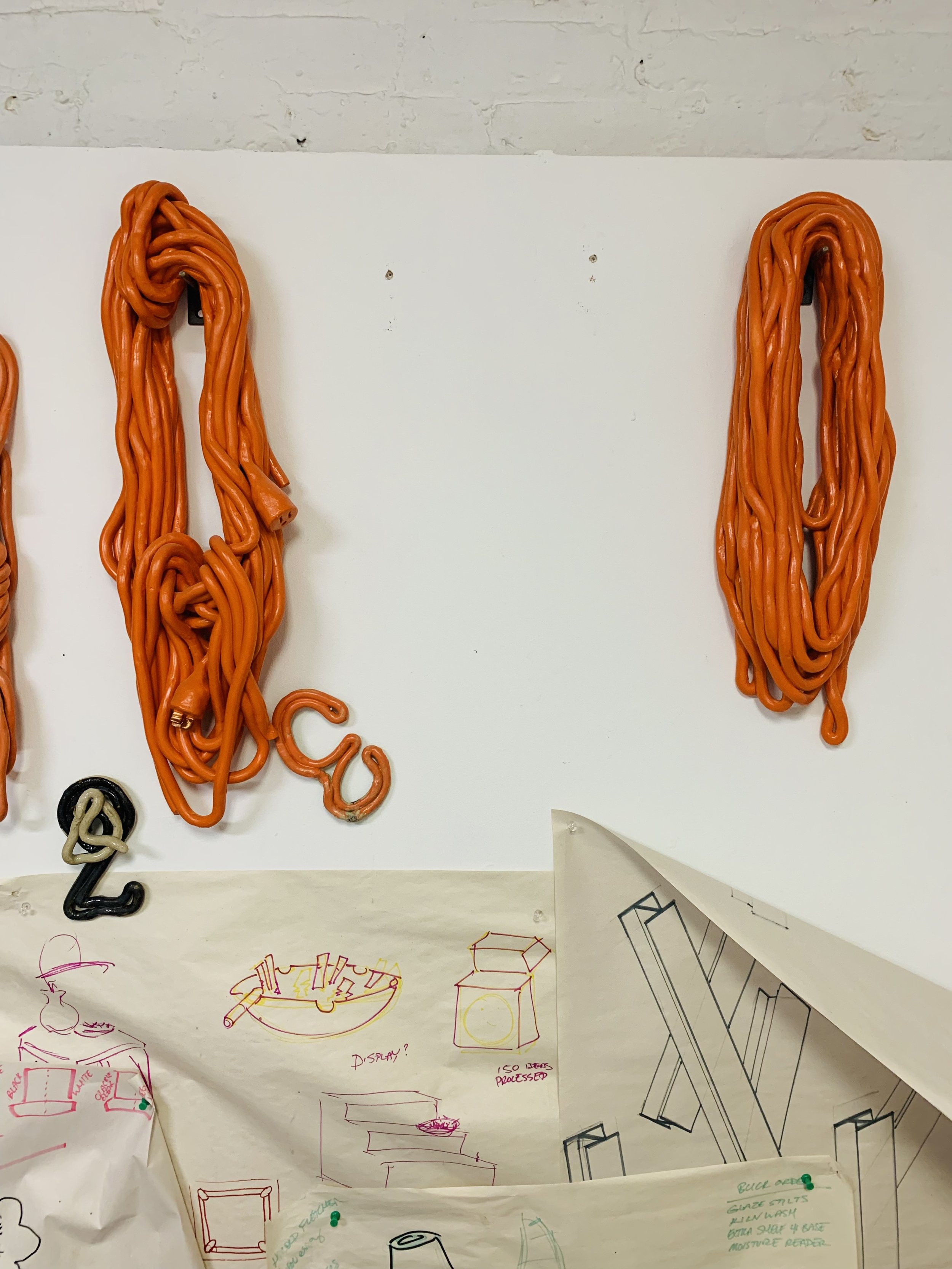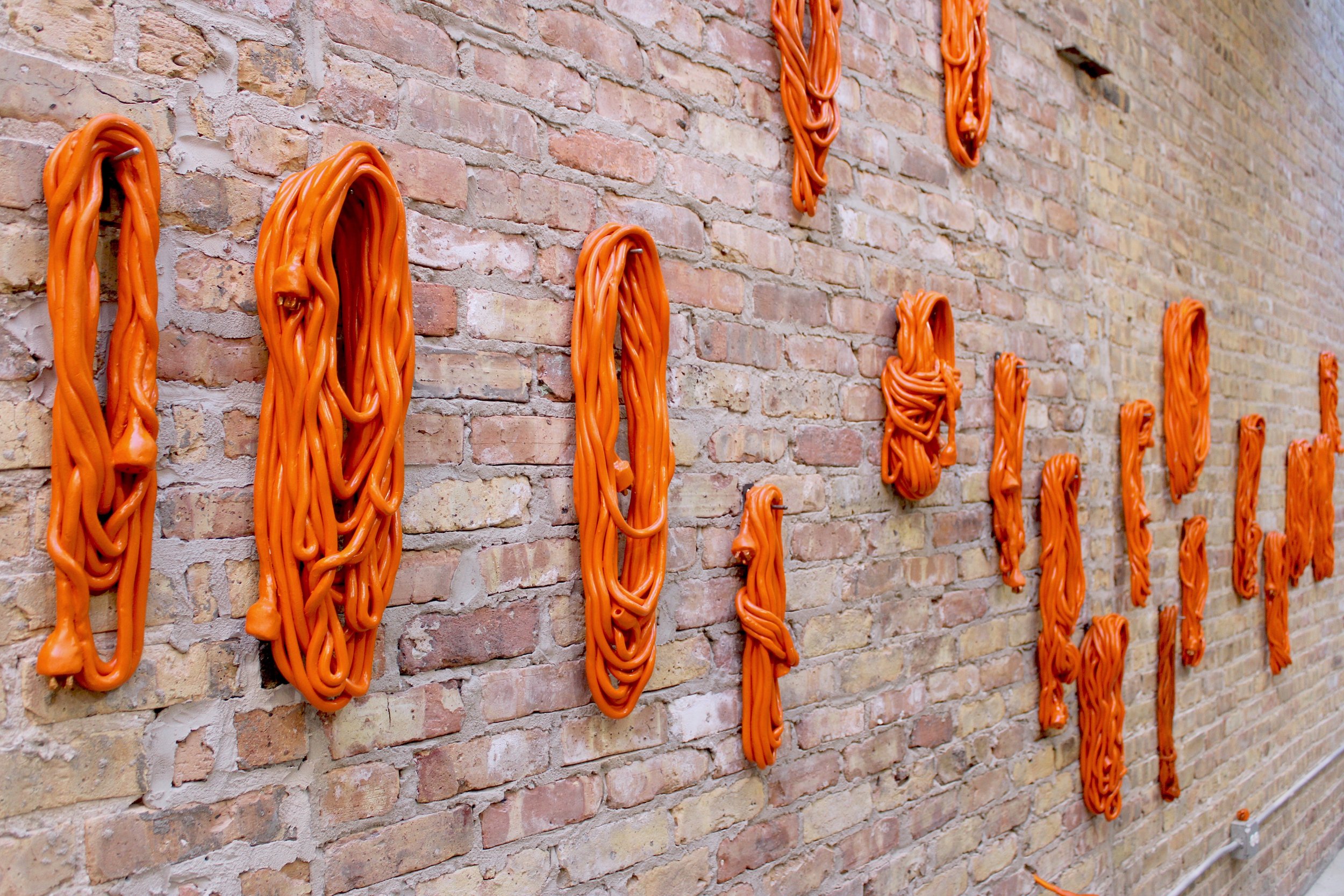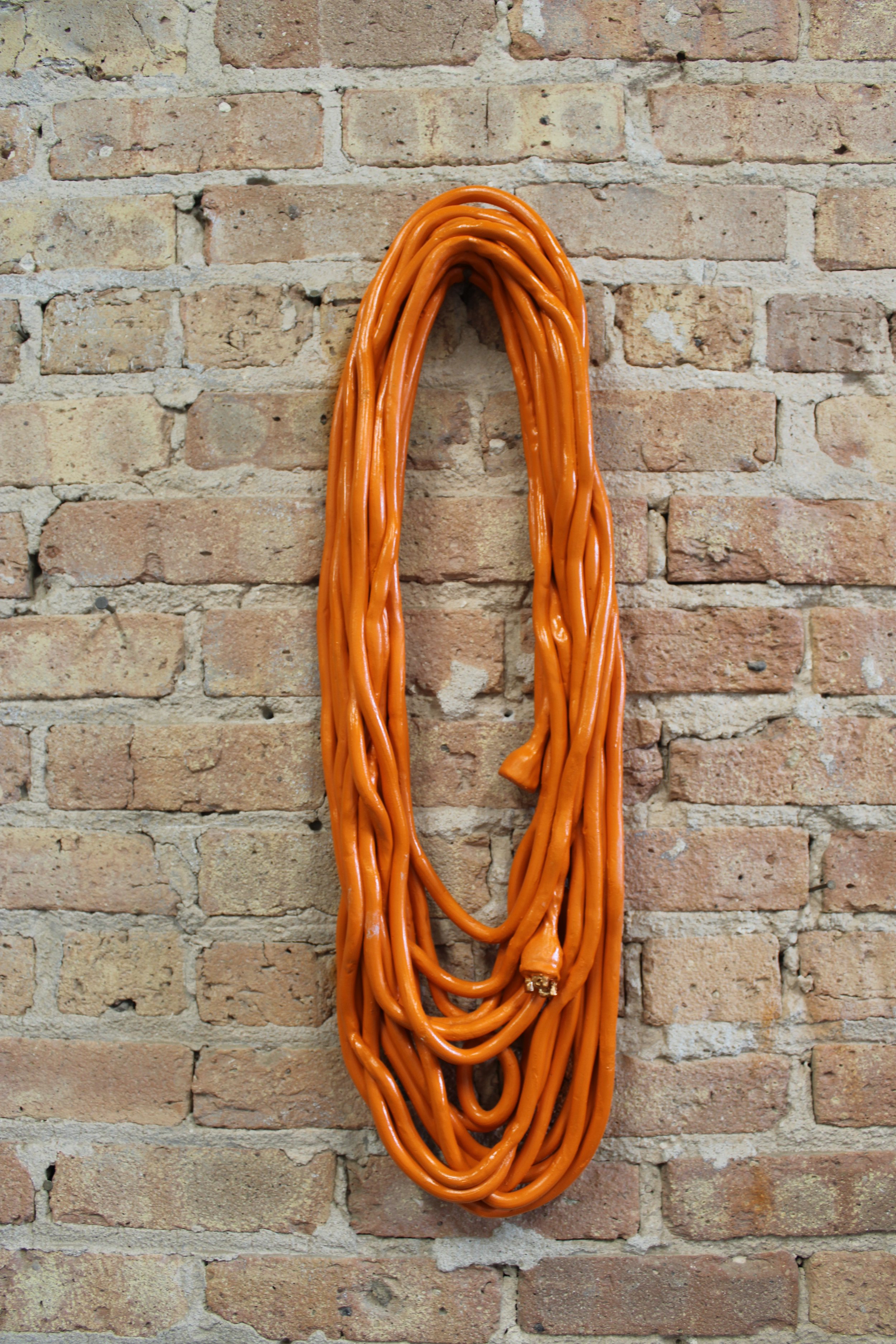Extension Cords
Stoneware, spray paint, copper paint, steel hardware
Sizes vary
2021 - ongoing
Thoughts on Extension Cords
I first got to thinking about extension cords as a subject matter a couple years ago when I was doing an install that involved a lot of technology. There were a lot of monitors, projections, media players, directional sound cones, etc all doing different things throughout the room, lots of different artists working in film or sound but touching on different subjects. In that same exhibition, there was an artist working with sound through sculpture and there were cables draped all over the work in a kind of a visual, sculptural way---embracing the flow of the cable as a part of the work.
As we were wrapping up the week of install, the curatorial team felt that we should put up conduit to cover the electrical cords leading the works to power outlets. This is standard practice; I’ve done it a million times, it is not an unusual request. My intern and I were set to the task of painting the conduit to match the wall colors, and arranging the cables in efficient, tidy lines running along the baseboards and ceiling creases in an attempt to blend the technology in with the architecture. When it came to the artwork that was explicitly addressing the blend of technology, sound and some sculptural aspects of these relationships, I found it terribly ironic that it was important to hide the cables that led that particular work to power.
I like to call this “cord management”. Cord management, in my mind, is defined as: “taking time to neatly arrange cables, cords and electrical elements by wrapping, tying and tucking them out of sight so as not to distract from the work itself”. In principle, I understand the necessity; so much of being a preparator is creating a “blank canvas” (pun intended) of a space--often referred to as “the white cube”--so that the artists’ work can be highlighted and all of the technical, structural, practical bits and pieces should be out of sight, out of mind. Though in some ways, I’ve always felt like this is a form of coddling the audience; are we not giving them enough credit? Does this practice imply that they may not be able to set aside the concept that electricity is, in fact, required to run this equipment, making it possible to view the video that they’re staring at? And furthermore, that it is not a conceptual element to the artwork up for consideration? Increasingly, artists are developing work that uses intellectual, art historical and field-specific language to address ideas that may not be instantly understood by the layman. But I would argue that even the most elementary of audiences could determine and separate out the idea that the television requires power and therefore needs to be plugged into the wall to function. The absurdity of the idea that we have to hide the symbols of work and utility is the foundation for the kind of work I’m currently interested in generating.
Working as a preparator, this culture of concept vs. context is injected in every aspect of the work that you perform. How can we surround the artwork with a halo of contextual isolation? How can we keep the audience in rapt awe of the object they are faced with? The answer is generally to remove distractions. In the gallery space, we attempt to maintain that the present time, current culture and political climate is the only context floating just below the surface of the exhibition. The patching, painting, wall-building, emails, construction sounds, design drawings, digital renderings, pulleys and ropes, mops and buckets, brooms and dustpans, piles of debris, tape measures, packing materials, label drafts, contracts, dollies, tiny holes, paint chips, cardboard, hand tools, zip ties, plastic sheets, painty rags, ethafoam, spent sandpaper, cotton gloves, gaffers tape, instructional sticky notes, blue tape, pencil lines, empty paint buckets, razor blades, saw dust, D-rings, picture hangers, sharpies, vinyl backing, sticky paint rollers, dried out chip brushes, dead screws, destroyed drill bits, sweaty rags, bandaids, baseball hats all need to be removed, despite being essential to the process of presentation in some way or another. It could be argued that it reflects a relationship to the studio of the artist---the not-so-secret prerequisite to objecthood. The objects listed above, more than anything else, are the constant in my line of work. The artwork is always different, but the craft of preparing space is the same.
There’s something mildly infuriating about being the agent of distraction. The work of an exhibition worker is meant to be disappeared. The lack of evidence of presence is a mark of success, warranting discreet thanks for simply doing your job. The act of stepping back and aside, neatly putting away the elements of your essential work in a utility closet, remaining generally unacknowledged, is the experience of working as an art-handler and preparator. I see the extension cords as a small act of un-hiding necessity. They represent something of a substantial support system that is a part of the undercurrent of “the art world,” an industry of ideas and commodities that encourages isolationism, elegance, and standards of precision. The gallery is a manufactured space where we attempt to create a kind of vacuum in an effort to push ideas forward while simultaneously pushing the technical aspects back.
The extension cord is both a literal and figurative representation of connection, separation and practicality; the space generates the power that fuels the work, and it is in a very real way, a parasitic relationship to power. In an effort to reverse this imbalance in my own exhibition, the cables rise to the top. The subtleties of the draping and folding of length, the idiosyncratic ways in which we wrangle, wrap and store something that is ugly and utilitarian, are moments that reflect my experience working as an agent of muting practicality. As plein air painters capture their environment, I am hoping to capture my own through the lens of hidden utility within the context of exhibition-making.



















